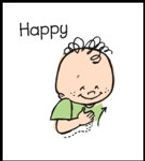
Talk with your baby BEFORE your baby learns to talk!
Have you ever wondered what your baby is thinking? Or why your baby is crying? The Baby Signs® Program teaches babies to use simple, easy-to-do gestures for communicating with their parent and caregivers. These gestures or "signs" represent an item or concept, "cat," "eat," or "all gone."
Using signs gives babies a way to "talk" with their parents before they can talk. Babies can communicate about the world around them long before they have mastered their verbal speaking skills.
Babies and toddlers often use signs as a natural part of the communication process. Many babies know how to wave "bye-bye" or use a headshake to mean "no". The Baby Signs® Program can help your baby use lots of other gestures to communicate just as easily as these more common "signs"

The Baby Signs® Program
The Baby Signs® Program helps children develop both language and cognitive skills. Babies who sign are able to develop speech sooner and long-term studies show these early skills can translate into better grades.
The Baby Signs® Program is based on the ground breaking research of Drs. Linda Acredolo and Susan Goodwyn, professors of Psychology and Child Development, which began an international movement to teach hearing babies to use signs. After 20 years of careful study funded by the National Institutes of Health, they proved that using signs enhances language, cognitive, and social-emotional development.
The Baby Signs® Program is the original sign language program for hearing babies. The publication of Baby Signs written by Drs. Linda Acredolo and Susan Goodwyn in 1996 was the catalyst for the development of the infant sign language movement, and it is an international bestseller that is currently available in 14 languages. The Baby Signs® Programs is a program that can be used anywhere in the world as it features universal signs. With over 500 top-notch Instructors in the U.S., Canada, Czech Republic, Hong Kong, Japan and New Zealand, the Baby Signs® Program has more instructors than any other program

The Benefits of the Baby Signs® Program
Families who use the Baby Signs® Program know first hand that there are many benefits to using signs with their babies. Using the Baby Signs® Program …
-
Reduces tears, tantrums, & frustration
-
Allows babies to share their worlds
-
Increases respect for babies
-
Strengthens the parent-infant bond
-
Boosts self-esteem and self-confidence
-
Makes learning to talk easier
-
Stimulates intellectual development
Over two decades of Baby Signs® research has shown that these proven benefits affect different areas of a child’s development. Using the Baby Signs® Program stimulates: *
-
Social-Emotional Development
-
Language Development
-
Cognitive Development

The Science of the Baby Signs® Program
Dr. Linda Acredolo and Dr. Susan Goodwyn, the authors of the book Baby Signs: How to Talk with Your Baby Before Your Baby Can Talk, have conducted over two decades of academic research on the use of signs with hearing babies, including a long-term study funded by the National Institutes of Health. Their ground-breaking research describes the proven benefits of the Baby Signs® Program. Their scientific study of over 140 families took place over a seven-year period and yielded some remarkable results. They conducted standardized assessments of children who participated in Baby Signs® groups and those in non-Baby Signs® groups at several stages in their development.
At 24 months, the Baby Signs® babies were on average talking more like 27 or 28 month olds. This represents more than a three-month advantage over the non-Baby Signs® babies. In addition, the 24 month old Baby Signs® babies were putting together significantly longer sentences.
At 36 months, Baby Signs® babies on average were talking like 47 month olds, putting them almost a full year ahead of their average age-mates. Eight year olds who had been Baby Signs® babies scored an average of 12 points higher in IQ than their non-signing peers.


